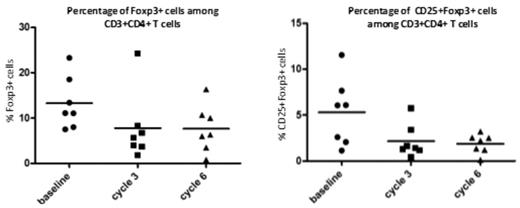Abstract
Introduction: Chronic lymphocytic leukemia (CLL) has multiple mechanisms of active immune suppression including expansion of T-regulatory cells which increases with progression of the disease. In addition, the malignant CLL cells were found to produce IL-10 in vitro and functionally recapitulate the phenotype of regulatory B cells. These regulatory "B10" (capable of producing IL10 after hours in vitro stimulation) or "B10 pro" (capable of producing IL10 after 2 days in vitro conditioning) are generally rare in healthy individuals, and play an important role in regulating inflammatory and autoimmune process. Similarly, CLL cells can exert tumor specific as well as global immune suppressive effect via IL-10 production. Ibrutinib, the first in class irreversible BTK inhibitor has been proved to be a safe and effective therapy for CLL. Recently we and others have demonstrated favorable cellular immune modulatory effects of ibrutinib through inhibition of an alternative target interleukin-2 induced T-cell kinase (ITK) that promotes Th1 CD4 polarization. Herein, we explore influence of ibrutinib on other immune suppressive features including T-regulatory cells and the B-regulatory phenotype associated with CLL cells.
Methods: PBMCs were collected from nine previously treated CLL patients treated with 420mg of ibrutinib daily per clinical trial OSU-11133 (NCT01589302) at the time of pretreatment, cycle 3 day 1 and cycle 6 day 1. For Brief stimulation (B10 condition), cryopreserved PBMCs were thawed and stimulated with PMA/Ionomycin/Golgi-stop plus CpG for 5 hours. For prolonged stimulation (B10-Pro condition), PBMCs were stimulated with CpG plus CD40L for 48 hours, PMA / Ionomycin / Golgi-stop were added for final 5 hours. The cells were then fixed / permeabilized and stained for intracellular IL-10. For FOXP3 staining, PBMCs were permeabilized and fixed with Foxp3 Buffer Set from eBioscience, and were stained with stained with PE conjugated anti-human Foxp3 antibody (clone 259D/C7).
Results: Significant IL-10 production was detected in 8 out 9 patient's CLL cells after 48 hours in vitro stimulation. Interestingly, CLL cells collected from patients treated with ibrutinib in vivo were significantly impaired in their capacity to make IL-10 in 7 out of the 8 patients whose CLL cells were capable of producing IL-10. On average, there is more than 4 fold reduction( P< 0.01) in the frequency of cells producing IL-10 by cycle 3, more than 5 fold reduction (P< 0.01) by cycle 6. (Figure 1 A, upper panel). IL-10 production after a brief 5 hour in vitro stimulation was observed in 4 out of the 9 patients studied, though the frequencies of IL-10 producing cells were low (Figure 1 A, lower panel). Samples collected post-ibrutinib treatment showed a trend towards reduced frequency of IL-10 producing CLL cells after 5 hour stimulation. We have also shown that during the first two cycles of ibrutinib, patients' plasma levels of IL-10 decreased. Analysis of potential immunosuppressive molecules revealed a dramatic reduction in surface expression of CD200, BTLA and PD-1 in CLL cells collected post ibrutinib treatment compared to pre-treatment samples (Figure 1B). We also found that for all the patients analyzed, the percentage of CD4+/Foxp3+ and CD4+/CD25+/Foxp3+ regulatory T cells were significantly reduced in samples collected after ibrutinib treatment. The difference is more dramatic for CD25+Foxp3+ cells (figure 1C).
Conclusion: Here we demonstrate a significant decrease in the frequency of T-regulatory cells and IL-10 competent "B-reg" like leukemia cells in CLL patients after ibrutinib treatment. Ability of CLL cells to produce IL-10 and their regulatory B cell like features are considered to play a major role in mediating both global and tumor specific immunosuppression in CLL patients. Ibrutinib has been reported to enhance the immune response against B cell lymphoma in a mouse model. Our findings provide potential mechanisms by which ibrutinib treatment relieve the immunosuppressive effect of malignant B cells, thus enhancing global as well as tumor specific immunity. The main mechanisms likely include impaired IL-10 production capability and reduced surface expression of immunosuppressive molecules by CLL cells, as well as reduced frequency of regulatory T cells and IL-10 producing T cells.
Maddocks:Novartis: Research Funding; Janssen: Research Funding; Pharmacyclics: Consultancy, Research Funding. Byrd:Acerta Pharma BV: Research Funding; Acerta Pharma BV: Research Funding.
Author notes
Asterisk with author names denotes non-ASH members.




This feature is available to Subscribers Only
Sign In or Create an Account Close Modal